Moroccan and Turkish older migrants in the Netherlands before the COVID-19 pandemic: lonely despite social contacts

Moroccan and Turkish older migrants in the Netherlands frequently feel lonely, not because they lack social relationships, Tineke Fokkema & Marjolijn Das note, but because of poorer health, lower socio-economic status and a sense of limited control over their lives. Migrant-specific and other general risk factors, such as language barriers, discrimination and unmet filial expectations, also likely play a role.
The first Moroccan and Turkish labour migrants1 came to the Netherlands in the 1960s and 1970s (Figure 1). They were mainly young men with little or no education who saw migration as a means to escape poverty in their country of origin. Although official recruitment agreements were concluded with Morocco (1969) and Turkey (1964), they did not play a major role in this migration: most of these first migrants came to the Netherlands on their own initiative. The government and the migrants themselves thought their stay would be temporary. However, contrary to expectations, and despite the economic recession after the 1973 oil embargo and the relocation of industrial production to low-wage countries, there was no mass return. This was partly due to the unfavourable political and economic prospects in the migrants’ countries of birth, combined with increasingly restrictive immigration policies that included a withdrawal of the “return option” enabling migrants to come back to Europe after returning home. Instead, many of the stayers brought their wives and children over through family reunification, as evidenced by the sharp increase in the proportion of Moroccan and Turkish women migrants from the 1970s onwards. Immigration of Moroccans and Turks subsequently decreased and the age of older adults (aged 55 and above) in the Moroccan and Turkish population increased considerably over the following years.
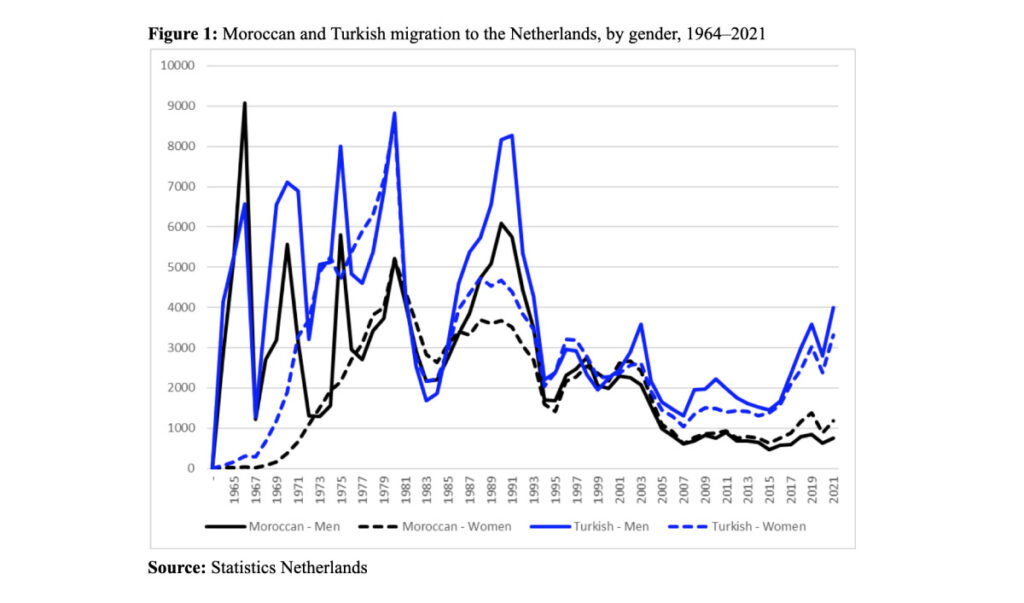
Between 1990 and 2020, the number of Moroccan older adults increased roughly tenfold and the number of Turkish older adults almost eightfold (see Figure 2). On 1 January 2022, there were 62,700 Moroccan and 68,500 Turkish older adults living in the Netherlands. Together they constitute 14% of the overall non-native population aged 55 and older in the Netherlands. As future older adults with a Moroccan and Turkish background are not expected to return en masse to their country of birth (or that of their parents), the size of these two groups of older adults will increase further. According to the most recent forecast by Statistics Netherlands, in 2050, the Dutch population will include approximately 181,600 older adults with a Moroccan background and 199,000 older adults with a Turkish background, representing 18.7% of the overall non-native population aged 55 and older. At the moment, the numbers of second-generation Moroccan and Turkish older adults are still negligible – less than 1% were born in the Netherlands. By 2050 the picture will be different: around four in ten older adults with a Moroccan or Turkish background will belong to the second generation.
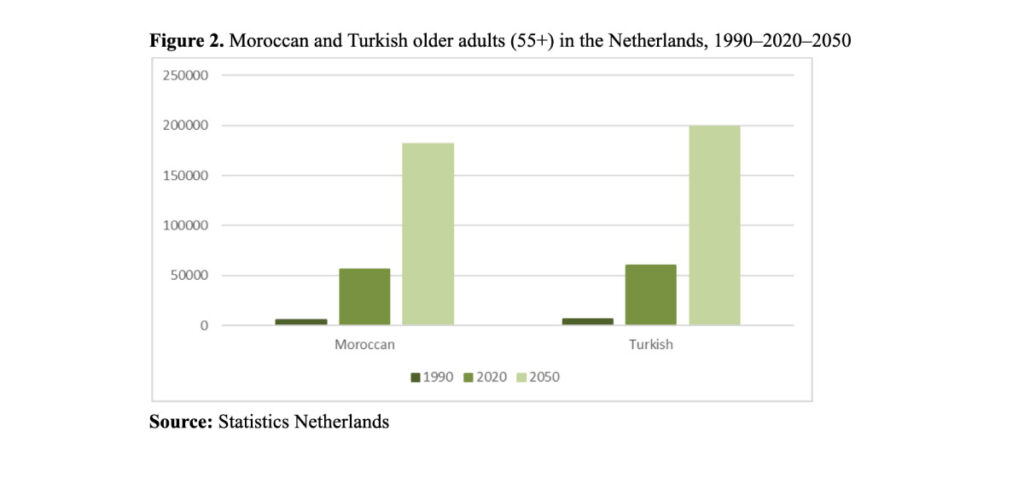
Lonely…
Loneliness – the perceived discrepancy between actual and desired social relationships – is much more prevalent among Moroccan and Turkish older migrants than among Dutch older adults. This is concerning, given the negative effects of loneliness on both mental and physical health (Cacioppo & Cacioppo, 2014). Using the 11-item De Jong Gierveld Loneliness Scale (DJGLS; de Jong Gierveld & van Tilburg, 1999), earlier research showed that 58% and 54%, respectively, of Moroccan and Turkish older migrants aged 55–64 are moderately lonely (score 3–8), compared to 21% of their Dutch peers (Fokkema et al., 2016). For severe loneliness (score 9–11), the differences between the groups are even greater. Almost one in four Turkish older migrants feels severely lonely, compared to 12% of Moroccan older migrants and 4% of Dutch older adults. A similar picture emerges from another study among older people aged 65+ in the four largest Dutch cities – Amsterdam, Rotterdam, The Hague and Utrecht – using a shorter 6-item version of DJGLS (de Jong Gierveld & van Tilburg, 1999): 64% of Moroccan and 69% of Turkish older migrants feel moderately or severely lonely (score 2–6), compared to 50% of their Dutch peers of the same age in the same city (El Fakiri & Bouwman-Notenboom, 2015).
…but not alone
Loneliness is often associated with people who live alone and have few contacts. Recent research, however, shows that this is not the case for Moroccan and Turkish older migrants in the Netherlands (Fokkema & Das, 2020). They have a partner slightly more often than Dutch older adults: 72 and 70% of Moroccan and Turkish older migrants, respectively, are married or cohabiting with a partner compared to 68% of older adults with a Dutch background. On average, Moroccan and Turkish older men are eight and four years older, respectively, than their spouse. The likelihood of widowhood is therefore greater for older women than for older men: 60% of the former have a partner versus 80% of the latter.
To add to the puzzle of severe loneliness, Moroccan and Turkish older migrants have more children on average than Dutch older adults and more often co-reside with one or several children (Fokkema & Das, 2020). Only 7% of Moroccan and 5% of Turkish older migrants are childless, versus 16% of Dutch older adults. Excluding childless persons, Moroccan and Turkish older migrants have 3.4 and 4.8 children on average, respectively, compared to 2.3 for their Dutch peers. Moreover, 53% of Moroccan and 44% of Turkish older migrants (not counting those who are institutionalised) live with one or more of their children. Among Dutch older adults, the share is 18%.
Children close-by
In old age, Moroccan and Turkish older migrants live much closer to one of their adult children (Fokkema & Das, 2020). Figure 3 shows the average distance in km to the nearest child: 4.7 km for Moroccan and 5.1 km for Turkish older migrants, compared to 13.5 km for Dutch older adults. While among the latter there is little difference in distance from sons and daughters, Moroccan and Turkish older migrants live closer to their sons than to their daughters. Figure 4 shows the proportion of older adults with one or several children living within a 5-km radius. Compared to their Dutch counterparts, Moroccan and Turkish older migrants are significantly more likely to have at least one child living close-by: 86% have at least one child living within a 5-km radius, compared to 63% of Dutch older adults. The differences become greater within a narrower radius of 1 km: more than half of Moroccan and Turkish older migrants have children living within 1 km of their home, compared to three in ten Dutch older adults.
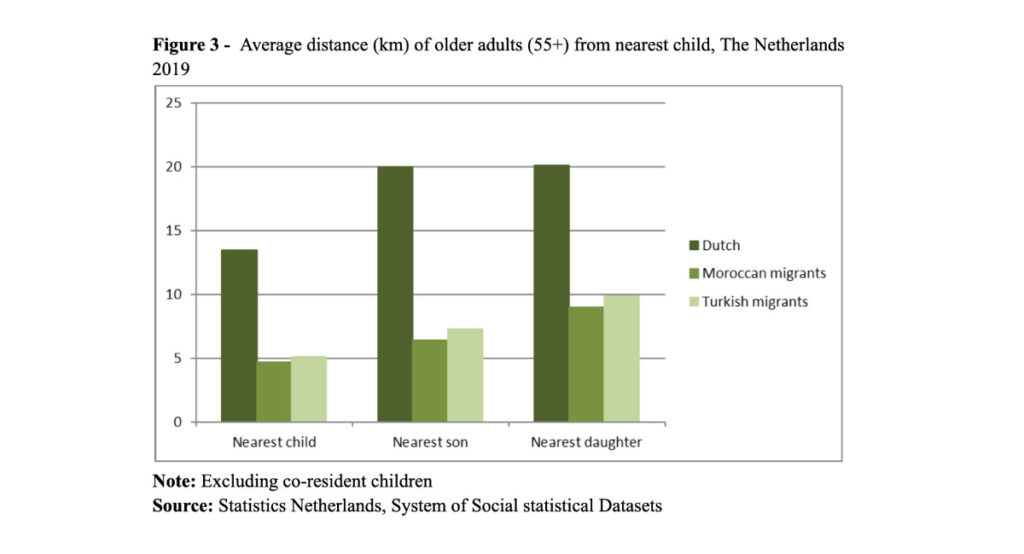
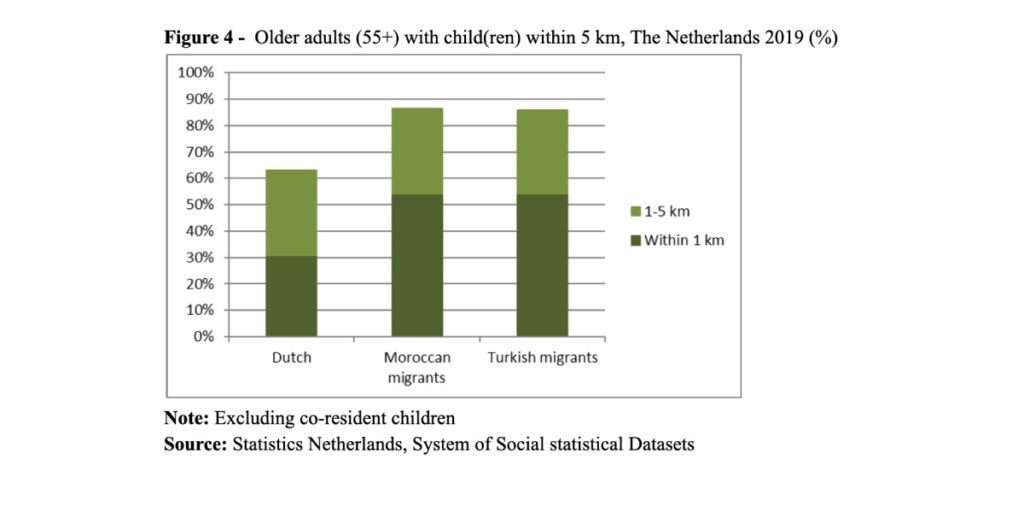
These differences between Moroccan and Turkish older migrants and their Dutch counterparts are partly due to their socio-demographic and economic characteristics and those of their children (Fokkema & Das, 2020). Among other things, on average, Moroccan and Turkish older migrants are younger, have more children, live in more densely urbanised areas and have a lower income than their Dutch counterparts. Furthermore, on average, their children are less educated than the children of Dutch older adults. All these characteristics are known to be related to the residential distance between parents and children and the likelihood of parents and children living together (Smits et al., 2010). However, even after correcting for a large number of socio-demographic and socio-economic characteristics in a regression analysis, Moroccan and Turkish older migrants are still more likely to live with children or close to them.
An additional explanation can be sought in the stronger norms and values relating to family solidarity that prevail within Moroccan and Turkish communities, where children have a duty to care for their elderly parents. This is in line with our findings (not presented here) that the likelihood of living either with or near children increases with age – the oldest-old are often more in need of help – and is highest among Moroccan and Turkish older migrants aged 75+, compared to “young-older migrants” aged 55 to 65. However, changing norms about family solidarity and a shift towards individualism in younger cohorts may also play a role here.
Co-ethnic people close-by
While older adults with a Dutch background live throughout the Netherlands, Moroccan and Turkish older migrants predominantly reside in large municipalities, especially in the four big cities (Fokkema & Das, 2020). This means that co-ethnic peers often live nearby. Of the older adults with a Moroccan background, 61% live in a very densely urbanised municipality, the vast majority (70%) in the four big cities (Figure 5). The respective proportions are around 50% and 80% among older adults with a Turkish background, and 17% and 46% among older adults with a Dutch background. While Moroccan and Turkish older migrants probably have less contact with Dutch people, this does not necessarily entail a negative effect on their social well-being. Previous research shows that a strong sense of belonging to one’s own ethnic group protects just as well against severe loneliness as a strong sense of belonging to larger Dutch society (Klok et al., 2017).
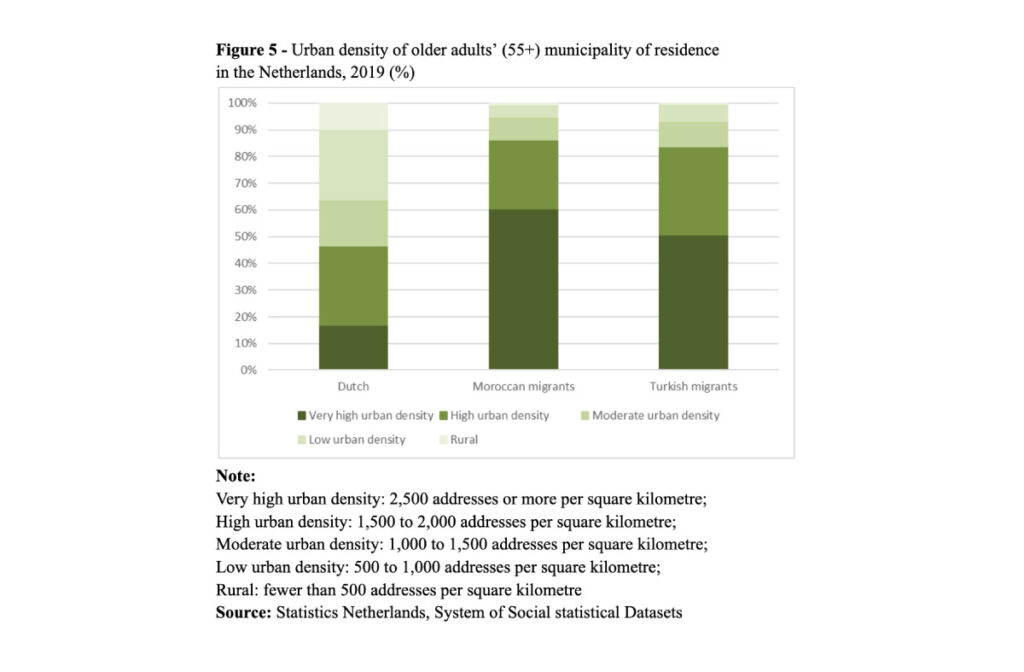
Risk factors for loneliness
If Moroccan and Turkish older migrants compare favourably with Dutch older adults in terms of “availability” of a partner, children and co-ethnic peers, why are they more lonely? Recent research has identified three general risk factors for loneliness: health problems, low socio-economic status and a perceived lack of control over life (van Tilburg & Fokkema, 2021). All these factors make it more difficult to engage in activities and establish new contacts. Moroccan and Turkish older migrants have poorer health, including a greater number of depressive symptoms, are less satisfied with their income, and experience less control over their own lives. The loneliness differential with respect to Dutch older adults drops by more than half when these differences are taken into account, but remains significant.
Further explanations could be sought in migrant-specific or other general risk factors. Several Dutch qualitative studies indicate that a language barrier, experiences of ethnic discrimination, living between two worlds (the Netherlands and Morocco/Turkey), and inadequate access to regular professional care play a role (Nhass & Verloove, 2020; Pot et al., 2020). Large-scale survey research is needed to confirm the effect of these migrant-specific risk factors on loneliness. Poor relationship quality or excessive, unrealistic expectations (for example about frequency of visits and support from children) among Moroccan and Turkish older migrants could also play a role, as loneliness arises when a discrepancy is experienced between actual and desired relationships, either in terms of quantity or quality. There are signs that the duty of care, taken for granted by parents, increasingly clashes with children’s busy work and family lives. When children cannot meet expectations, this might lead to friction in the parent-child relationship, feelings of disappointment and rejection, and ultimately loneliness. However, here too, hard quantitative evidence is lacking.
To conclude
It is gradually becoming clear that Moroccan and Turkish older migrants in the Netherlands are particularly vulnerable in terms of their social well-being. Although surrounded by family members and co-ethnic peers, they report loneliness much more frequently than Dutch older adults. To get a better grip on the causes – besides relatively poor health, low socio-economic status and lack of control over life – further in-depth research is needed. In addition, it would be interesting to see whether this high prevalence of loneliness also occurs among younger cohorts of migrants, to examine whether loneliness is specific to their migrant status, and perhaps also to determine whether the experiences of the current cohort of older migrants are unique.
Footnote
1“Migrants” refers to persons born abroad and with at least one parent born abroad (first generation). “Migration background” or “non-native” refers to both first-generation and second-generation migrants (persons born in the Netherlands and with at least one parent born abroad). “Dutch” refers to persons whose parents were both born in the Netherlands.
References
Cacioppo, J. T., & Cacioppo, S. (2014). Social relationships and health: The toxic effects of perceived social isolation. Social and Personality Psychology Compass, 8(2), 58–72. doi: 10.1111/spc3.12087
de Jong Gierveld, J., & van Tilburg, T. G. (1999). Manual of the loneliness scale. Vrije Universiteit, Department of Social Research Methodology, Amsterdam.
El Fakiri, F., & Bouwman-Notenboom, J. (2015). Gezondheid van oudere migranten in de vier grote steden [Health of older migrants in the four big cities]. Amsterdam: GGD.
Fokkema, T., & Das, M. (2020). Familienetwerken van niet-westerse oudere migranten [Family networks of non-Western older migrants]. CBS: Jaarrapport Integratie 2020, pp. 190–214.
Fokkema, T., Welschen, S., van Tilburg, T., & Thomése, F. (2016). Eenzaamheid onder oudere migranten: Literatuuronderzoek en interviews [Loneliness among older migrants: Literature research and interviews]. Amsterdam: Ben Sajetcentrum, Vrije Universiteit.
Klok, J., van Tilburg, T. G., Suanet, B. A., Fokkema, T., & Huisman, M. (2017). National and transnational belonging among Turkish and Moroccan older migrants in the Netherlands: Protective mechanisms against loneliness? European Journal of Ageing, 14(4), 341–351. doi: 10.1007/s10433-017-0420-9
Nhass, H., & Verloove, J. (2020). Tussen verveling en vereenzaming: Een kwalitatief onderzoek naar hoe ouderen met een Marokkaanse achtergrond eenzaamheid en ouder worden in Nederland beleven [Between boredom and loneliness: A qualitative study of how older adults with a Moroccan background experience loneliness and ageing in the Netherlands]. Utrecht: Kennisplatform Integratie & Samenleving.
Pot, A., Keijzer, M., & de Bot, K. (2020). The language barrier in migrant aging. International Journal of Bilingual Education and Bilingualism, 23(9), 1139–1157. doi: 10.1080/13670050.2018.1435627
Smits, A., van Gaalen, R. I., & Mulder, C. H. (2010). Parent-child coresidence: Who moves in with whom and for whose needs? Journal of Marriage and Family, 72(4), 1022–1033. doi: 10.1111/j.1741-3737.2010.00746.x
van Tilburg, T. G., & Fokkema, T. (2021). Stronger feelings of loneliness among Moroccan and Turkish older adults in the Netherlands: In search for an explanation. European Journal of Ageing, 18(3), 311–322. doi: 10.1007/s10433-020-00562-x